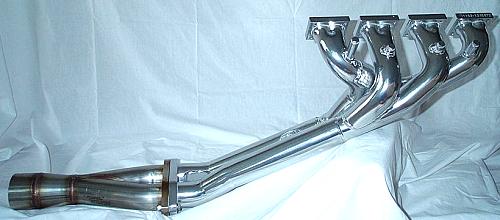
| ||||||||||||||||
|
The driving reason behind this custom 3" exhaust project was that I needed an exhaust to match the Evo III header that I planned on using. As mentioned earlier, the Evo III header has the same part number as the 2.5 L Group A header listed in the BMW Motorsport Gr A catalog. This header has larger secondaries than either the stock 2.3 L header or the popular "Rally Header". What is commonly called the Rally header is a stainless steel two piece design that actually has the same part number as both the 2.3L Gr A header and the Evo II header. Confused? Yes, it's confusing :^| | ||||||||||||||||
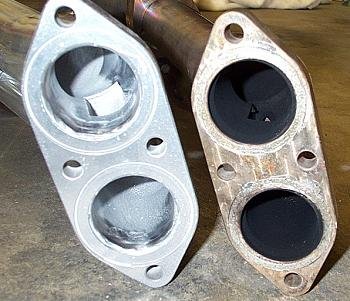 The bottom line is that if you want to use an Evo III header you will need either an
Evo III exhaust, or you'll have to build your own exhaust. That is because the tubing diameter
of the standard 2.3L exhaust is smaller than that of the secondaries on the Evo III header.
The photo on the right shows what I'm getting at. We see an Evo III header vs. a 2.3L Gr A
header. The smaller header outlets of the 2.3L Gr A header are still compatible with a stock 2.3L exhaust. But the
Evo III header outlets are noticeably larger.
You might be able to physically get an Evo III header to attach to the 2.3L exhaust system
if you use smaller diameter bolts, but it's not ideal. You will get a downward step in the
tube diameter right before the X-Pipe, which from a theoretical point of view is bad for performance.
The bottom line is that if you want to use an Evo III header you will need either an
Evo III exhaust, or you'll have to build your own exhaust. That is because the tubing diameter
of the standard 2.3L exhaust is smaller than that of the secondaries on the Evo III header.
The photo on the right shows what I'm getting at. We see an Evo III header vs. a 2.3L Gr A
header. The smaller header outlets of the 2.3L Gr A header are still compatible with a stock 2.3L exhaust. But the
Evo III header outlets are noticeably larger.
You might be able to physically get an Evo III header to attach to the 2.3L exhaust system
if you use smaller diameter bolts, but it's not ideal. You will get a downward step in the
tube diameter right before the X-Pipe, which from a theoretical point of view is bad for performance.
| ||||||||||||||||
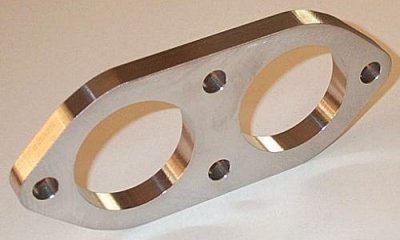 As mentioned above, the hole pattern in the flange of an Evo III
header does not quite mate up with the hole pattern in the 2.3L exhaust. The holes are spaced
apart more to make room for the larger diameter pipes. It's not much of a difference, you can
sort of make it work with undersize bolts. But that's not the best way to go. If you decide
to make your own exhaust to match up with an Evo III header then you also have to make up a
custom flange
that matches the hole pattern in the Evo III header. The flange will also
need to accommodate a larger tubing diameter than the standard sized flange (2.25" vs.
1.77" for the factory 2.3L exhaust). The photo shows a custom 304 stainless steel flange made to adapt
to the Evo III header.
As mentioned above, the hole pattern in the flange of an Evo III
header does not quite mate up with the hole pattern in the 2.3L exhaust. The holes are spaced
apart more to make room for the larger diameter pipes. It's not much of a difference, you can
sort of make it work with undersize bolts. But that's not the best way to go. If you decide
to make your own exhaust to match up with an Evo III header then you also have to make up a
custom flange
that matches the hole pattern in the Evo III header. The flange will also
need to accommodate a larger tubing diameter than the standard sized flange (2.25" vs.
1.77" for the factory 2.3L exhaust). The photo shows a custom 304 stainless steel flange made to adapt
to the Evo III header.
| ||||||||||||||||
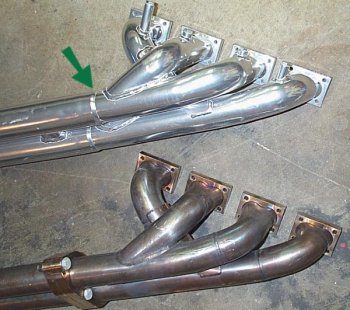 Here is an Evo III header next to a 2.3L Gr A header. Remember that the 2.3L Gr A header is also called
a Rally header by some and it shares the same p/n as the Evo II header. The 2.3L Gr A header is a two-piece
design and is welded from sections of mandrel bent tubing. The Evo III header is made from single pieces of
mandrel bent tubing (they may have been crush bent, but if they were then it was very well done).
The Evo III header in these photos has been Jet Hot coated. It comes from the factory
looking pretty dull, just like the stock 2.3L header. But it is still stainless steel. Just use a magnet
to convince yourself of that. The dark green arrow points out the obvious "step" where the tubing increases
diameter as it leads into the secondaries. Such steps are used today in F1 headers, where they are used as part
of the pressure tuning, as well as simply to increase the diameter of the tubing to enhance flow capacity.
Thus, although the first pair of "Y's" are a primary part of the pressure tuning on this "Tri-Y" design, the "steps"
in the Evo III header may add additional pressure reflection points.
Here is an Evo III header next to a 2.3L Gr A header. Remember that the 2.3L Gr A header is also called
a Rally header by some and it shares the same p/n as the Evo II header. The 2.3L Gr A header is a two-piece
design and is welded from sections of mandrel bent tubing. The Evo III header is made from single pieces of
mandrel bent tubing (they may have been crush bent, but if they were then it was very well done).
The Evo III header in these photos has been Jet Hot coated. It comes from the factory
looking pretty dull, just like the stock 2.3L header. But it is still stainless steel. Just use a magnet
to convince yourself of that. The dark green arrow points out the obvious "step" where the tubing increases
diameter as it leads into the secondaries. Such steps are used today in F1 headers, where they are used as part
of the pressure tuning, as well as simply to increase the diameter of the tubing to enhance flow capacity.
Thus, although the first pair of "Y's" are a primary part of the pressure tuning on this "Tri-Y" design, the "steps"
in the Evo III header may add additional pressure reflection points.
| ||||||||||||||||
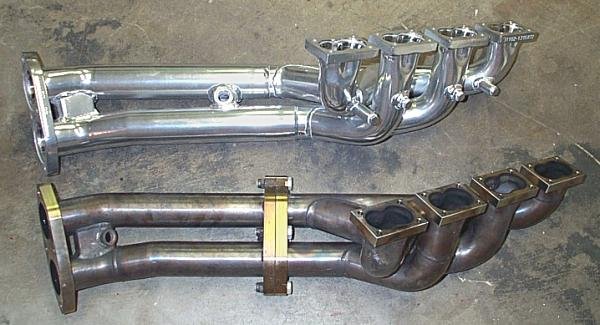
| ||||||||||||||||
| In the photo above note the H-Pipe in the Evo III header where the fitting for the O2 sensor is placed. The two piece header does not include this feature. How significant this H-pipe is to the pressure tuning of the Evo III header is unclear. It's effect may be of secondary importance. Also note that the Evo III header has ports allowing measurement of individual CO out of the 4 cylinders. The two-piece header, which seems to be more "race-oriented", does not have these. The two-piece header also does not include the O2 sensor fitting as it comes from BMW. In this case the fitting was welded on afterwards. One must ensure that it is welded at an angle so the O2 sensor clears the underside of the car. | ||||||||||||||||
|
Included below are some measurements of header tube diameters, both for the primaries and the secondaries. These measurements were taken by me, using a set of digital calipers, on headers that I've owned. No second hand information is included here.
| ||||||||||||||||
|
Note that none of these headers are "equal length". This fact is somewhat surprising, even though it is obvious once you look at it. The primaries are quite clearly not the same length. And careful measurement shows that even the secondaries are not the same length. You might wonder why it would even be desirable to have an equal length header. Well, if all the primaries are the same length then the rpm at which the first pair of Y's becomes effective will be the same for every cylinder. That's because the pressure waves travel at the speed of sound, regardless of tube diameter. It's only the length of the tubes between junctions and steps that affects pressure tuning. So with an equal length header, where the distances are all the same, an engine will "come on the pipe" at a very specific rpm. That makes good power, but it's not great for driveability. By making the lengths of the primaries and the secondaries "uneven" BMW may have been trying to spread the effectiveness of the pressure tuning over a wider rpm band. Not as good for power, but giving more "area under the curve" so to speak. | ||||||||||||||||
|
Click here to see a 4-into-1 S14 DTM header. | ||||||||||||||||
|
Click here to see another 4-into-1 S14 header. | ||||||||||||||||
|
Page 6 » | ||||||||||||||||
|
| ||||||||||||||||